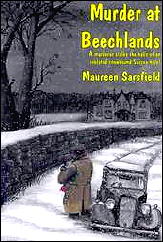Sun 10 Jun 2018
MAUREEN SARSFIELD – Murder at Beechlands. The Rue Morgue Press; trade paperback; 2003. Originally published in the UK as Dinner for None, Nicholson & Watson, 1948. First published in the US as A Party for Lawty, Coward-McCann, 1948.

I wonder how many of you have ever heard of Maureen Sarsfield before starting to read this review? Not many, I don’t imagine, and yet, on the basis of my reading this one just now, perhaps you should have.
Not much is known of the author. She wrote two mysteries and one mainstream novel, Gloriana, the latter never published in the US and good luck on finding a copy. For the sake of completeness, her other mystery is:
Both mysteries feature the same detective, Inspector Lane Perry, but I’m getting ahead of myself. When the folks at Rue Morgue Press, Tom and Enid Schantz, publish a book, their introductions always provide in-depth looks not only at the book itself but also at the author, chatty and informative. Maureen Sarsfield has them stumped, this time. The lady seems to have disappeared without a trace, leaving behind her all sorts of questions, such as, why only the two detective novels and no more?
Al Hubin’s Crime Fiction IV happens to have a piece of data the Schantzes don’t include in their introduction to Murder at Beechlands, and that is that the author’s real name was Maureen Pretyman. (On the Rue Morgue website, I see, however, that they do mention that she wrote children’s books under that name, so it isn’t something they don’t know.)
One of the ways of coming up with a detective novel is to reinvigorate the well-used idea of the isolated mansion house where murder has occurred, with any one of the people in the house capable of being the guilty party. Beechlands is such a mansion, sort of. What it is really isa drab but dowdy hotel in Sussex, and the blizzard that snows in all of the guests (some paying, some not), staff and servants is the same storm that forces Inspector Parry’s car off the road, just in time to have him witness the discovery of a body during an outdoor snowball party.
Soon enough the phone lines are cut, reducing drastically the chances that the dead man either fell or jumped out of the window on his own, but the burglar alarms are left on, making sure that no one can escape without being noticed. Every so often a recap (of who may have done what to whom, and who was where when) is offered, which was not a bad idea on the author’s part, because that is 99% of what this detective novel is about.
After a while, in fact, you may even get the idea, if this is your kind of story to begin with, that too much of a good thing is not so good after all.
But the author’s sure hand on keeping the reader’s eye away from what is essential is also a key ingredient, which is a small inside joke on my part, because as soon as the key to the hotel safe is found, all of the mystery immediately begins to unravel. The characters themselves are minor beings, Lane Perry included, but some of the readers of this story may eventually find themselves becoming wistful about some of them.
The England in this story is long past, and so is the type of mystery this is. One certainly may wonder why Maureen Sarsfield never wrote more than the two detective novels she did, but on the other hand, the day for detective novels like this one was waning as soon as it was first written. If this is the kind of mystery story you like, however, you will really like this one.
NOTES: Enid Schantz died in 2011, and while I don’t know the exact date, Rue Morgue Press closed down operations shortly thereafter. The website referred to in this review is no longer active.
Bill Deeck reviewed this same book earlier on this blog. You can read his comments here.
June 10th, 2018 at 2:56 pm
One paragraph that was deleted from my original review talked about Rue Morgue Press thusly:
“Tom and Enid Schantz, the folks behind Rue Morgue Press, have instead carved a niche for themselves in the world of detective fiction by publishing the works of such lesser known authors as Frances Crane, Norbert Davis, Gladys Mitchell, Kelley Roos, Clyde B. Clason, Juanita Sheridan, and – Maureen Sarsfield.”
In 2005 they were essentially the only game in town as far as reprinting mystery fiction from the Golden Age of Detection was concerned. Today it is almost impossible to keep up with all of the detective novels from the 20s 30s and 40s being reprinted. It is as if we are in a second Golden Age.
But Tom and Enid Schantz were there first, and I hope they’ll always be remembered for that.